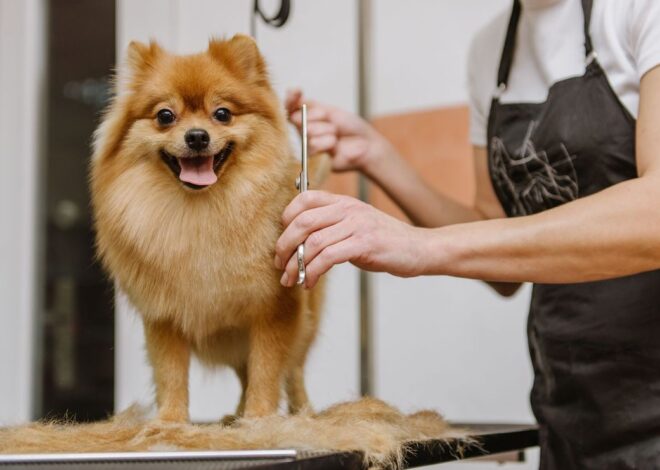
How to Maintain a Healthy Weight for Your Dog: Diet and Exercise Tips
Maintaining a healthy weight for your dog is crucial to their overall wellbeing. Just like humans, dogs benefit from a balanced diet and regular exercise. An appropriate weight not only keeps your dog looking their best but also prevents common health issues such as arthritis, heart disease, and diabetes. Here’s a comprehensive guide to keeping your furry friend in top shape through diet and exercise.
Understanding Your Dog’s Ideal Weight
Before diving into tips for maintaining a healthy weight, it’s essential to know what’s considered a healthy weight for your dog – this varies based on breed, age, and size. If you’re unsure, consulting with your veterinarian is the best way to establish a target weight for your pet. You can also check your dog’s body condition at home by feeling for their ribs – they should be easily felt without being visible. A visible waistline when viewed from above is another good sign of a healthy weight.
Diet: The Foundation of a Healthy Weight
Your dog’s diet is the cornerstone of their health. Ensuring they’re eating the right amount and type of food is critical for maintaining an appropriate weight.
- Choose High-Quality Dog Food: Always opt for high-quality dog food that provides the necessary nutrients without too many fillers. Whole ingredients like real meat, vegetables, and grains are much better than processed foods with artificial additives. Avoid overfeeding, even with healthy food, as portion control is essential.
- Monitor Portion Sizes: Many pet owners tend to overestimate the amount of food their dogs need. Use feeding guidelines provided on dog food packaging, but adjust as necessary based on your dog’s activity level, metabolism, and age. Puppies and more active dogs might require more food, while older, less active dogs may need smaller portions.
- Be Mindful of Treats: Treats are a great way to reward your dog, but they should be given in moderation. Opt for healthy, low-calorie treats and account for them in your dog’s daily caloric intake. It’s also worth considering using kibble from their regular food as a treat during training sessions to avoid unnecessary weight gain.
- Add Probiotics to Their Diet: A healthy gut is essential for proper digestion and nutrient absorption, which can help manage your dog’s weight. If your dog is showing signs of digestive issues, it could be worth investigating whether they need probiotics. Look for signs your dog needs probiotics, such as diarrhoea, excessive gas, or a dull coat. Probiotics can help maintain a healthy gut flora, leading to better digestion and overall wellbeing.
Exercise: Keeping Your Dog Active
Exercise is just as important as diet when it comes to maintaining a healthy weight for your dog. It keeps their muscles strong, joints flexible, and helps burn off extra calories.
- Daily Walks: Walking is one of the best forms of exercise for dogs. Aim for at least 30 minutes to an hour of walking each day, depending on your dog’s age, size, and breed. Some dogs may need more physical activity, so make sure you cater to their specific needs. Not only does walking keep them fit, but it also stimulates their mind with new sights and smells.
- Playtime: Incorporating play into your dog’s daily routine is an excellent way to keep them active. Fetch, tug-of-war, or even chasing a ball around the yard can be a fun and effective workout for your dog. These activities also strengthen the bond between you and your pet.
- Mental Stimulation: In addition to physical activity, mental exercise can help keep your dog fit. Puzzle toys, obedience training, or even teaching them new tricks can engage their brain and prevent them from becoming bored and potentially overeating.
Tailored Exercise Plans for Different Breeds
Some dogs are naturally more active, while others are content with shorter bursts of exercise. For example, working breeds like Border Collies or Labradors may require more intensive activities such as running or agility training. On the other hand, smaller breeds or older dogs might benefit from more gentle, regular walks. Always tailor the exercise plan to your dog’s needs to avoid overexertion.
Regularly monitoring your dog’s weight and adjusting their food and exercise routine as needed is key to maintaining their health. Weigh your dog every few weeks and check their body condition regularly. If you notice any significant weight gain or loss, consult your vet to rule out any underlying health conditions and make necessary adjustments.
Maintaining a healthy weight for your dog is an ongoing process that requires attention to both diet and exercise
By providing high-quality food, controlling portion sizes, incorporating probiotics when necessary, and ensuring they get enough physical activity, you’ll be setting your dog up for a longer, happier, and healthier life. Keeping an eye on their weight and regularly checking in with your vet will also help prevent health issues down the track. With the right balance of nutrition and exercise, your dog will thrive and enjoy an active, healthy lifestyle by your side.


